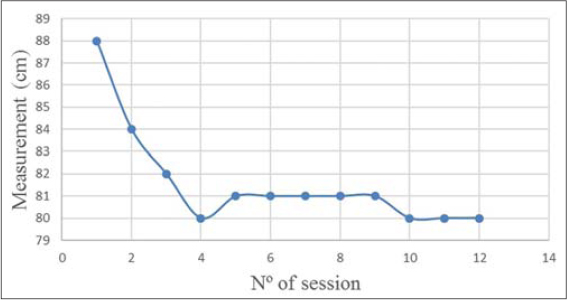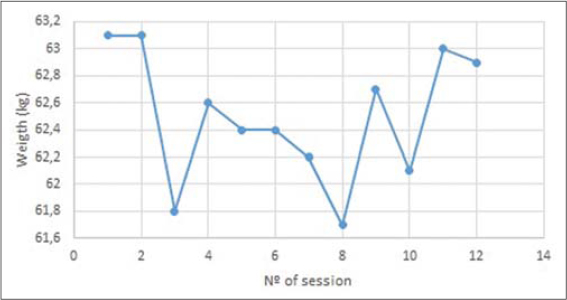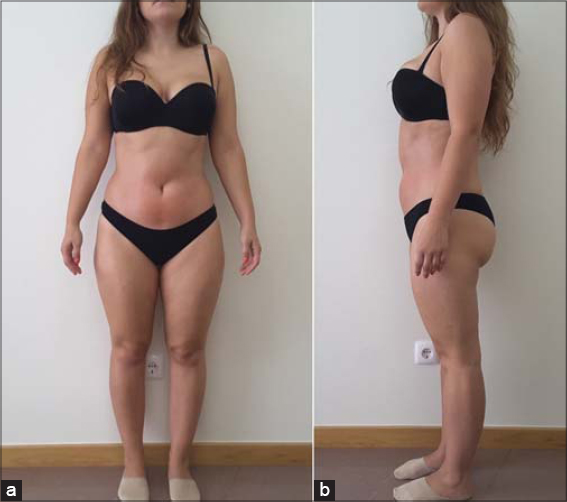Elaboration and subsequent application of a protocol for measuring reduction in a patient with Hashimoto thyroiditis
Clínica Áurea – Aesthetic Biomedicine Clinic; Rua de Três Lagares, bloco 1,loja G, 5000-577 Vila Real, Portugal
Corresponding author: Dr. Sara Gonçalves
Submission: 19.03.2020; Acceptance: 14.05.2020
DOI: 10.7241/ourd.20203.4
Cite this article: Gonçalves S. Elaboration and subsequent application of a protocol for measuring reduction in a patient with Hashimoto thyroiditis. Our Dermatol Online. 2020;11(3):243-246.
Citation tools:
Copyright information
© Our Dermatology Online 2020. No commercial re-use. See rights and permissions. Published by Our Dermatology Online.
ABSTRACT
Background: Hypothyroidism is the result of insufficient production or absence of production of thyroid hormones. Weight gain is one of the side effect of this autoimmune disease. In this paper a protocol for the reduction of measures for a Hashimoto thyroiditis patient was performed and the obtained results were analyzed.
Material and Methods: The patient is female of 26 years of age, with an initial weight of 63.1 kg and a height of 160 cm. Body mass index (BMI) of 24.6. She presents hyperlipodystrophy in the abdominal area and thighs and cellulitis in the thigh area.
Results: There was a weight loss associated with measurement of the reduction of abdomen and thighs.
Conclusions: Treatments consisting in measuring reduction help in reducing body measurements, but following a good diet and practicing exercise are also required.
Key words: Hashimoto thyroiditis, Measurement of reduction, Aesthetic biomedicine, Nutrition
INTRODUCTION
Chronic autoimmune thyroiditis is the most frequent thyroiditis and is the most common cause of hypothyroidism in countries where diet provides a sufficient supply of iodine [1]. It is also called chronic lymphocytic thyroiditis or Hashimoto’s thyroiditis.
Up to 95% of cases occur in women [1]. It affects people of all ages, especially those in their 30s and 50s. The incidence of this thyroiditis has increased exponentially over the last 50 years, which may be related to the increase in iodine content in the diet [2].
The natural course of the disease is the gradual loss of thyroid function [3]. Among patients with this condition who exhibit moderate increases in TSH and in the presence of anti-thyroid antibodies, hypothyroidism affects up to 5% of the general population.
The main clinical manifestations are the signs and symptoms of hypothyroidism [4].
Due to the insidious evolution of the disease, the doctor will find patients with less specific complaints, such as: weight gain (moderate), constipation or fatigue [5].
MATERIALS AND METHODS
The initial consultation and subsequent treatments were developed in Clínica Áurea – Clínica de Biomedicina Estética, Portugal.
In the initial consultation, all the procedures were explained, as well as side effects, expected results and contraindications.
The patient signed informed consent.
The patient is a female of 26 years of age. Initial weight of 63.1 kg and a height of 160 cm. Body mass index (BMI) of 24.6.
She presents hyperlipodystrophy in the abdominal area and thighs and cellulitis in the thigh area.
In the initial consultation, the measurements described in Table 1 were taken, which will serve as a reference for each treatment session and to facilitate the evaluation of results. Initial photos were also taken (Figs. 1a and 1b).
 |
Table 1: Measurements at the first consultation |
 |
Figure 1: (a) Initial photo: frontal. (b) Initial photo: lateral. |
The patient reported that she did not want to perform mesotherapy treatments, because she had already done it in the past and it had been quite painful.
Although the area being evaluated was the abdomen, a thigh protocol was also performed (Table 2 and 3).
 |
Table 2: Measurement of reduction in the abdomen |
 |
Table 3: Measure reduction for thighs |
The patient was provided with information regarding the foods that she could consume and those that would have to be avoided, based on the analysis of the potential triggers of autoimmune diseases upon the outcomes of previous research (Table 4).
 |
Table 4: Foods recommended and advised against based on the analysis of the potential triggers of autoimmune diseases |
Ethics Statement
The procedures followed were in accordance with the ethical standards of the responsible Committee on Human Experimentation (institutional and national) and the Helsinki Declaration of 1975, as revised in 2000 and 2008.
RESULTS
After 12 treatment sessions, the results are as follows (Figs. 2 – 4).
 |
Figure 2: Measurement of the abdomen throughout the sessions. |
 |
Figure 3: Measurement of the thighs throughout the sessions. |
 |
Figure 4: Weight measures along the sessions. |
Final photos were also taken (Figs. 5a and 5b).
 |
Figure 5: (a) Final photo: frontal. (b) Final photo: lateral. |
DISCUSSION
The patient presented at the initial consultation a weight of 63.1 kg and height of 160 cm, with a BMI of 24.6.
According to the BMI chart, the patient (26) has normal weight for her height. After analyzing the percentage table of fat mass for females, she is in the “healthy” range.
The results confirm that the patient has lost volume and weight, a fact that is noticed by the loss of centimeters in both the abdomen and the thighs (Figs. 3 – 5).
The BMI was not altered.
The patient confirms that she notices improvements in the cellulitis in the thigh area and that the skin is much smoother.
CONCLUSION
The lack of improvement in the percentage of fat mass (initial: 30.9, final 33.6) is due to the fact that the patient confirmed that she did not exercise during the treatment and did not follow the recommendation of foods to eat and avoid.
These treatments help in reducing the body measurements, but it is also necessary to follow a good diet and practice exercise. The patient was advised to attend nutrition consultations and exercise to continue to reduce weight.
The majority of subjects with thyroid disease experience problems in maintaining normal body weight and have a higher body mass index and waist circumference than healthy individuals [6].
The role of diet in autoimmune diseases seems to be important but the true extent of its influence and the therapeutic potential are still largely unknown in this context.
Physical exercise is of equal importance to enhance the results that the treatments provide.
However, these two major reasons are not responsible alone for weight loss. If there is a hormonal imbalance, which many people with Hashimoto’s thyroiditis experience, then it will be extremely difficult to lose a significant amount of weight by eating and exercising alone [7]. Eating a lot of refined foods and skipping meals affects two of the major hormones in the body, cortisol and insulin [8]. If these habits continue for many years, this will put stress on the adrenal glands and can eventually lead to insulin resistance [9]. Until this is corrected, even with a perfect diet and exercise pursued on a daily basis, losing weight will be difficult.
Many people with Hashimoto’s thyroiditis and other types of hypothyroidism also have an imbalance in the ratio between the hormones estrogen and progesterone, which can also lead to weight gain and thus make it difficult to lose weight [10]. The patient was advised to consult with a competent endocrine doctor, as they will be able to detect a hormonal imbalance.
Statement of Human and Animal Rights
All procedures followed were in accordance with the ethical standards of the responsible Committee on Human Experimentation (institutional and national) and with the Helsinki Declaration of 1975, as revised in 2008.
Statement of Informed Consent
Informed consent was obtained from all patients for being included in the study.
REFERENCES
1. Chiovato L, Magri F, CarléA. Hypothyroidism in context:where we’ve been and where we’re going. Adv Ther. 2019;36(Suppl 2):47-58.
2. Mincer DL, Jialal I. Hashimoto thyroiditis. StatPearls Publishing;2020. Accessed May 12, 2020.
3. Publishing HH. The lowdown on thyroid slowdown. Harvard Health. Published 2019. Accessed May 13, 2020.
4. Abbott RD, Sadowski A, Alt AG. Efficacy of the autoimmune protocol diet as part of a multi-disciplinary, supported lifestyle intervention for Hashimoto’s thyroiditis. Cureus. 2019;11:e4556.
5. Schumaker T, Censani M. Growth failure and excessive weight gain in a 10 year old male with obesity:approach to diagnosis, management, and treatment of acquired hypothyroidism. Front Pediatr. 2018;6:166.
6. Wojtas N, Wadolowska L. Evaluation of qualitative dietary protocol (diet4hashi) application in dietary counseling in hashimoto thyroiditis:study protocol of a randomized controlled trial. Int J Environ Res Public Health. 2019;16. pii:E4841.
7. Kouidrat Y, Diouf M, Desailloud R, Louhou R. Effects of a diet plus exercise program on thyroid function in patients with obesity. Metab Open. 2019;2:100008.
8. Mohiuddin A. Skipping Breakfast Everyday Keeps Well-Being Away. Glob J Pharm Pharm Sci. 2019;7:1-7.
9. Ahola AJ, Mutter S, Forsblom C, Harjutsalo V, Groop P-H. Meal timing, meal frequency, and breakfast skipping in adult individuals with type 1 diabetes –associations with glycaemic control. Sci Rep. 2019;9:20063.
10. Mousa U. Fat Distribution and metabolic profile in subjects with Hashimoto’s thyroiditis. Acta Endocrinol Buchar. 2018;14:105-12.
Notes
Source of Support: Nil,
Conflict of Interest: None declared.
Request permissions
If you wish to reuse any or all of this article please use the e-mail (brzezoo77@yahoo.com) to contact with publisher.
| Related Articles | Search Authors in |
|
 http://orcid.org/0000-0002-8287-1357 http://orcid.org/0000-0002-8287-1357 |




Comments are closed.